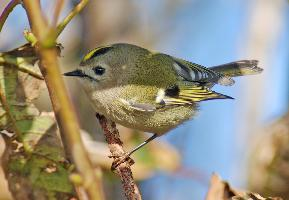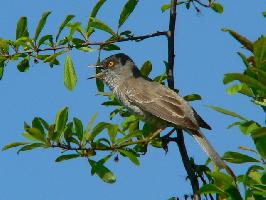
Description de l'animal
The Goldcrest (Regulus regulus) is a diminutive yet captivating bird, holding the title as the smallest bird species in Europe and one of the smallest passerines worldwide. This bird is a member of the kinglet family, a group known for their small size, vibrant plumage, and lively behavior. The Goldcrest measures approximately 8.5 to 9.5 centimeters in length and weighs between 4 to 7 grams, embodying the essence of a featherweight avian species.Distinguished by its striking appearance, the Goldcrest has olive-green upperparts that blend seamlessly with the foliage, providing it with excellent camouflage against predators. Its underparts are a lighter, more subdued shade, varying from greyish-white to pale yellow. The most distinctive feature of the Goldcrest, however, is the vibrant yellow stripe atop its head, bordered by black stripes on either side. In males, this yellow stripe can be flared into an impressive crest, which may turn a vivid orange when the bird is excited or during courtship displays, giving the species its name.
The Goldcrest's face features large, dark eyes, which are vital for spotting the tiny insects that make up its diet. Its bill is thin and sharply pointed, perfectly adapted for picking insects and spiders from the bark and leaves of trees. Despite its small size, the Goldcrest is a voracious feeder, constantly on the move in search of food.
These birds are renowned for their restless energy, flitting from branch to branch with a distinctive flight pattern that combines rapid wing beats with glides. Their calls are equally vibrant, consisting of a high-pitched, thin 'tsee-tsee-tsee' sound, which, despite its volume, can sometimes be difficult for human ears to detect due to its high frequency.
Goldcrests are primarily found in coniferous forests, but they also inhabit mixed woodlands, gardens, and parks, especially during migration. They have a wide distribution, spanning across Europe, North Africa, and Asia, with many populations choosing to migrate to warmer regions during the winter months. Despite their small size, these birds are capable of remarkable feats of endurance, including crossing the North Sea during migration.
Breeding season for Goldcrests involves the construction of a remarkable, hammock-like nest, delicately woven and suspended from the twigs of a conifer tree. The female exclusively undertakes the task of building this intricate structure, using materials such as moss, spider webs, and feathers, making it almost invisible to predators. She lays a clutch of 6 to 12 eggs, which she incubates for about two weeks. Once hatched, both parents are involved in feeding the voracious chicks, which fledge approximately three weeks later.
Despite their tiny stature, Goldcrests play a significant role in their ecosystems as pest controllers, consuming vast quantities of insects. They are also a symbol of resilience and adaptability, thriving in a variety of habitats and weathering the challenges of migration. The Goldcrest's vibrant presence, remarkable for such a small bird, continues to enchant birdwatchers and nature enthusiasts alike, embodying the wonders of the avian world in miniature.
Animaux similaires
Nouvelles photos d'animaux
Top 10 des animaux
- Dolphin gull (Leucophaeus scoresbii)
- Diana monkey (Cercopithecus diana)
- Moustached guenon (Cercopithecus cephus)
- Galápagos tortoise (Geochelone nigra complex)
- Russian tortoise (Testudo horsfieldii)
- Japanese macaque (Macaca fuscata)
- Stone loach (Barbatula barbatula)
- Greek tortoise (Testudo graeca)
- Common flying dragon (Draco volans)
- Colossal squid (Mesonychoteuthis hamiltoni)


